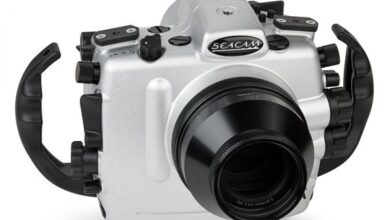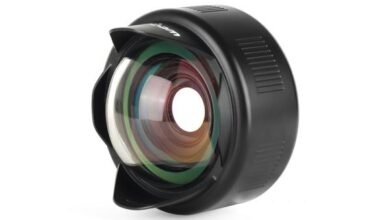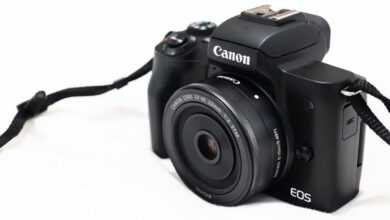Why Full Frame Didn’t Suit Me and Why I Won’t Leave Micro Four Thirds

You’ve probably heard many outright lies about Micro Four Thirds. It’s suffered attacks from certain quarters, sometimes from those openly in the pay of its competition. Here’s everything you need to know about the system and why it’s a great option for professional and amateur photographers alike.
Why Full Frame Is a Misnomer
Firstly, Micro Four Thirds is commonly called a crop frame system. That is sometimes said with a derogatory tone. I don’t agree with that term or that opinion.
So-called full frame cameras are also cropped when compared to medium format cameras. However, the photographic industry inevitably uses the 35mm format as the baseline for comparing different sensors. So, it is almost impossible to talk about the system without talking first about what we wrongly call full frame.
I believe it was Canon that first borrowed the term “full frame” to describe 35mm sensors. Though now in common usage, it’s a misnomer. It originally referred to the gate size in cinematography cameras. The gate is the part of the camera that held the film, and the term “full frame” was coined when the Academy ratio (as in the Academy of Motion Picture Arts and Sciences) was introduced in 1932. That ratio was 1.37:1. In other words, the 35mm 3:2 film was effectively cropped to a 4:3 ratio. Although it was superseded by widescreen in 1953, the full frame aspect ratio is still sometimes used in films such as Wes Anderson’s “The Grand Budapest Hotel” and “Asteroid City.”
So, the original full frame 4:3 aspect ratio is that is used by Micro Four Thirds, not 35mm sensors.
What Is the Difference Between Micro Four Thirds and 35mm Sensors?
The difference between the sensor in a Micro Four Thirds camera and that is a 35mm camera is size. The former has a diagonal width of 21.6mm (0.85”), and the latter is around double that at 43mm (1.7”). As with everything in photography, there are advantages and disadvantages to both these sizes.
The Obsolete Arguments Against Micro Four Thirds
Historically, many photography pundits have concentrated on three supposed disadvantages of the Micro Four Thirds format and ignored the advantages.
Firstly, is noise. With the newest sensor technology, it’s possible to shoot in very low light and have acceptable levels of noise with Micro Four Thirds. If you then consider the amazing AI-based noise reduction software that’s available, crisp, clean images are achievable at ISOs that were previously unrealistic, even for 35mm cameras.
Secondly, having more depth of field at any given focal length is an advantage in many circumstances. When that extra depth isn’t wanted, it can be circumvented by using different shooting methods, such as changing proximity and focal length, to achieve the desired effect. Furthermore, some extremely fast lenses are available for Micro Four Thirds that produce beautiful bokeh.
The third supposed disadvantage is built around a half-truth. Although equivalent f-stops will give more depth of field on a Micro Four Thirds camera, if you put it side-by-side with a 35mm camera, and set the ISO and aperture to be the same, the shutter speed will be identical. An f/1.4 lens is f/1.4 no matter which camera body it is mounted on.
So, Does That Sensor Size Difference Matter?
If you had asked me that a few years ago, then I would have answered yes. I shot professionally with Four Thirds DSLRs and then the mirrorless Micro Four Thirds systems. Very rarely, in extreme circumstances, I was hindered by the extra noise. Consequently, I debated with myself whether I should change to 35mm. Furthermore, for a few weeks, I owned a 35mm camera, but that’s another story.
Yet, camera technology has improved so much over the last few years that any contemporary camera, including Micro Four Thirds, produces images in extreme lighting conditions that are more than good enough. That’s the key term: more than good enough. In some areas, more expensive, far larger 35mm camera systems might perform better, but is that necessary when a smaller system does the job perfectly well?
Consequently, I still use Micro Four Thirds professionally. I am glad I didn’t change and am now reaping the benefits of the smaller cameras. I have some big, internationally known, household-name clients, and I shoot for national magazines. None of them complain about my work or the image quality. Plus, I have all the advantages of the smaller and lighter kit.
Never Listen to the Doom and Gloom Merchants
Not so long ago, the ill-informed doom and gloom merchants – some of whom were paid to promote other systems – tried to claim that Micro Four Thirds was failing. Keep an eye out for them in the article comments sections. As always, they were wrong.
Meanwhile, the booming sales of cameras like the OM System OM-1, the unprecedented demand for some lenses, the continuing popularity of cameras such as Panasonic’s GH Series, the use of the system in some DJI drones, and cinema cameras made by Black Magic all show that it’s a thriving and growing system. There are currently 56 companies listed as supporting the Micro Four Thirds format, far more than any other system.
Furthermore, because Micro Four Thirds has been around for many more years than the latecomers to mirrorless cameras, they have a greater variety of lenses and a proven track record for reliability.
APS-C Versus Micro Four Thirds Cameras
For most amateur photographers, other cameras with smaller than 35mm sensors do a good enough job too. I even knew a wedding photographer who used a Canon APS-C camera.
However, although the image quality of contemporary APS-C sensors is good, those produced by the most common manufacturers haven’t had anything like the development seen in 35mm or professional Micro Four Thirds camera systems. Consequently, many of them lack the functionality that camera enthusiasts and professionals seek. This is a generalization, of course, and there are exceptions. For example, Fujifilm, Leica, and Pentax all produce super cameras with APS-C sensors, albeit aimed at different and particular specialisms.
However, none have the advanced features that you will find in professional-end Micro Four Thirds cameras. Also, unlike Micro Four Thirds, there’s very little inter-brand compatibility.
Lenses Are Central to Photography
Do smaller sensors increase the focal length of a lens? It’s not strictly true that they do, although that is the effect you get.
With APS-C and similar-sized sensors such as Nikon’s DX, Canon’s EF-S and EF-M, and Sony’s DT and E mounts, the field of view is approximately ⅔ that of the 35mm camera. So, a 50mm lens on an APS-C camera gives you the same field of view as around 80mm lens on a 35mm camera. With Micro Four Thirds, the field of view would be about the same as a 100mm lens on a 35mm camera.
Consequently, my 150-400mm f/4.5 Micro Four Thirds lens has the same frame-filling capacity as an 800mm lens on a 35mm camera. However, it will be a lot lighter and smaller. If I activate its internal teleconverter, it has a 1000mm equivalent reach.
Comparing Like for Like
No two systems produce identical lenses, but we can get close. Let’s compare, for example, two professional telephoto prime lenses. In size and weight, the (I believe discontinued) Canon EF 300mm 1:4 L IS USM Lens and the OM System 300mm F4 IS PRO lenses are similar. They also both produce excellent quality images one would expect from professional lenses.
There are differences, however. The OM System has double the reach and provides four stops of lens image stabilization, six when working in conjunction with the camera’s IBIS. Meanwhile, the Canon gives two and doesn’t work with the IBIS. The OM System lens has 0.48x magnification, and the Canon has 0.24x. The OM System lens has a minimum focusing distance of 1.4 meters, the Canon is 10cm further away at 1.5 meters. Moreover, using these lenses, I find the extra depth of field afforded by the Micro Four Thirds lens an advantage as I can get an entire subject in focus without stopping down the aperture.
I am not saying the Canon lens is bad, it isn’t. It was fabulous in its day. However, the OM System equivalent outperforms it in many areas.
I should emphasize that the Canon lens does not seem to be available now, but it is a reasonable comparator. As is the lighter, but plastic-bodied Nikon equivalent. Again, a superb lens but plastic construction and has some decentering issues.
What About Pixel Count?
It wasn’t that long ago when the Pixel Wars were a-raging and people were crying out for 10- or 12-megapixel cameras. Then Sony brought out the A900 and Nikon the D3X with their greater than 24-megapixel cameras. It wasn’t long before 36-megapixels and above were above them. Meanwhile, Micro Four Thirds has stuck with between twenty and twenty-five megapixels.
When you can get 50-megapixel cameras in smartphones, why did Micro Four Thirds stop in the twenties?
The answer to that had much to do with consumer demand. Research showed that camera users wanted greater dynamic range and noise control over a higher pixel count. That is achieved by having a lower pixel density on the sensor and, therefore fewer pixels.
Furthermore, 20-megapixels is more than enough for most people. Whitewall will print a 63” (160 cm) x 47.2” (120 cm) from my files. I could also use software to upscale to a much higher resolution if I needed it; as of yet, I haven’t. My camera also has a trick up its sleeve where it uses sensor-shift technology to create up to 80-megapixel composite images. As fabulous as that feature is, I’ve never used it. It’s not something I need. However, that feature does have an advantage over sensors with a higher resolution.
Cameras with huge pixel counts sound great in theory, but they are limited by the performance of the lenses. Having a high-megapixel camera is no advantage when the lens can’t resolve images with that amount of detail. Phone cameras with 50-megapixel counts have no better resolution than 30-megapixel cameras because of the limited resolution performance of the lenses.
For the same reason, if you have a collection of older DSLR lenses designed for lower-resolution cameras, you won’t be able to notice that great a difference in fine detail buying a higher-resolution camera. Of course, camera manufacturers are producing new lenses for you to buy to get around this issue.
But this is where a camera that combines several 20-megapixel images has an edge. The OM System Hi Res mode captures information between the original 20 MP photosites. That gives a result that would have been from an 80 MP smaller pixel sensor but with the light-gathering advantage of a 20 MP sensor with larger photosites.
Should You Buy a Micro Four Thirds Camera?
I’m not suggesting that you should immediately dump your 35mm camera and buy a Micro Four Thirds one. There’s probably not much wrong with the camera you have, and you enjoy using it.
However, if you are struggling to lug that heavy gear around, or need something lighter for traveling, or want something that will fit in your coat pocket, or desire a longer reach from your lenses, or require something that you can take anywhere with you without looking like a member of the paparazzi, or you hanker after some of the computational technological advances that are not in your camera, or would like to be inspired by something new, then Micro Four Thirds has come of age and is now an exceedingly good option.
Yes, there are still arguments for using 35mm cameras, not least because there is peer pressure in the industry to do so. However, there are also good reasons to break free from the norm and embrace Micro Four Thirds. Since doing so, I haven’t looked back.




